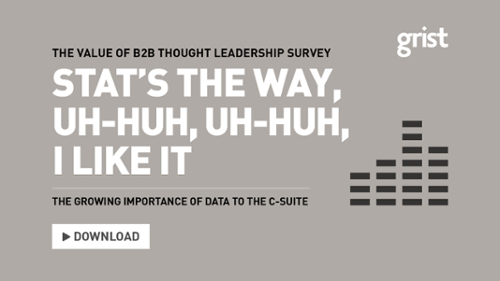Accepted wisdom in B2C marketing says that ‘people like us’ are the ones we listen to. Furthermore, it is demographics like age, ethnicity, gender and location that are considered the strongest indicators of who those ‘people like us’ are. However, in B2B marketing ‘people like us’ has a completely different meaning.
In our latest research on thought leadership, Grist asked respondents, when considering survey-driven thought leadership, how important is it that the target respondent is like you in terms of the following attributes: job responsibility, job title, job function, industry/sector, region, country, size of company, age and gender. The results show how B2C and B2B marketing differ when it comes to who their target audience want to hear from.
Job roles and responsibilities matter most
Our survey showed that, analysing responses from people with similar job responsibilities and roles is far more valuable than analysing those from the same age or gender. These people’s experiences and viewpoints will prove most useful when building thought leadership.
We found the most important peer attributes for both quantitative and qualitative research are, in fact, job responsibilities – CEOs want to hear from other CEOs and managers from other managers. The experience of people with similar job responsibilities will be more useful in making the business decisions these leaders seek help with when they turn to thought leadership.
Job title vs job function vs job responsibility
Job responsibility slightly edged out job title and job function in our survey. On the surface these three terms could be seen as interchangeable, but with no standardised job title across industries, let alone regions, responsibility could be seen as a catch-all for ‘people like me’. We believe what respondents find most interesting are the opinions of those in charge of similar projects, objectives and teams. A CFO in one company may be a financial director in another, and
The Asian experience is key for Asian readers
Our respondents are from enterprise-level companies so we’re not talking about small local businesses. Our sample spans high-revenue entities with large numbers of employees. Therefore, when we discuss job responsibilities it is simple enough to extrapolate that to different countries and regions, with one notable exception… Asia.
The difference between the two research methods should be kept in mind when looking at regional variations here. In Asia, a very complicated and multifaceted region, location does, in fact, matter when it comes to research.
Asia Pacific as a region covers everything from the West (Australia, New Zealand) to the East (China) and everything in between (Singapore, Hong Kong, Malaysia, Thailand, and so on). Just as the cultures are very different, so too are the experiences of businesses in these countries – not just from a compliance and operations standpoint but from a business mindset and approach, too.
So perhaps it comes as no surprise that, when isolating responses by region and country, they are more important in Asia Pacific than anywhere else. This was one of the biggest areas of discrepancy in our survey. We’ll look in more detail at regional comparisons in a future report.
Asia Pacific is also the only region that nominated age of respondent as an important attribute (60% quantitative; 52% qualitative), which makes sense for cultures where experience and age are so highly respected.
The Asian experience illustrates the need to remember cultural differences, whether when designing the survey or analysing responses. While location of respondents may not be important to the end user, it might skew results, so careful analysis is needed.
Right audience, right results
For any survey-driven thought leadership campaign to hit the mark, who is surveyed is paramount. Our own research shows that when it comes to B2B marketing, job responsibility is far more important to respondents than say age or gender, for example. It is those people whose experience and expertise will help drive your thought leadership campaign. However, when it comes to Asia, we recommend further consideration is taken when designing your survey. Get the audience right, and the results will follow.
For more insights, download the full report: The Value of Thought Leadership: The Growing Importance of Data.



